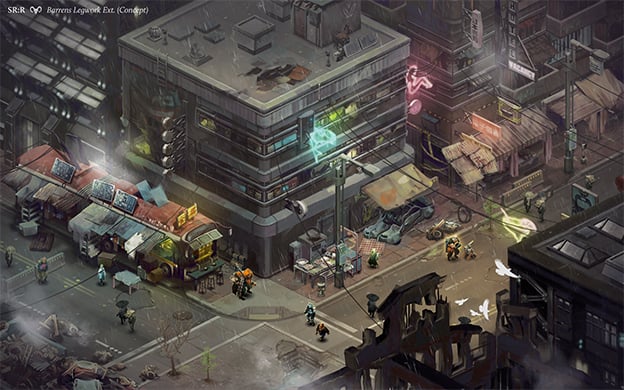Jack In, Sneak Out, Level Up
With a pending release date in late June, Shadowrun Returns is slated to be the first million-dollar-plus video game Kickstarter project to actually materialize. Its launch could be important not only for its developers and backers, but for the entire video game Kickstarter movement. If the game is well-received, it could spur continued crowdfunding growth, but if it flops, it could inspire gamers to think twice before funding future projects.
What is this game that serves as the first major milestone for a massive movement? Gamers may be familiar with the Shadowrun franchise in its main form as a pen ‘n’ paper (PnP) RPG or from old console games found on the SEGA Genesis and SNES. In essence, the world of Shadowrun blends the cyberpunk and fantasy genres to create a dystopian future in which soulless mega-corporations run everything, and hacker (or rather, “Decker”) dwarfs work alongside spell-slinging trolls. Shadowrun Returns is a single-player RPG with turn-based combat set in that world. It’s being developed by a team led by Jordan Weisman, one of the original creators of the setting.

Like many of the big RPG Kickstarter projects, Shadowrun Returns hearkens back to classic PC RPGs like Baldur’s Gate and Planescape: Torment. Along with the aforementioned turn-based combat, it features 3D characters in a 3D isometric environment, plenty of story and dialogue choices, tons of statistics, party-based gameplay, and a great deal of character customization.
The player will primarily control one main character, a Shadowrunner who takes on dirty jobs for the corporate powers who control the world. The player chooses this character’s gender, fantasy race, and basic skillset at character creation. Although no one character can do everything well, Shadowrun Returns uses a classless system, allowing for a great deal of ability customization. Players will have the option to build, for example, a character with shamanistic and hacking skills or one with samurai and magic-using abilities.

Although there’s only one main character, the player will have the ability to hire fellow Shadowrunners in order to have a balanced team with all the skills needed to complete missions. At least some of these party members will play an important part in the game’s main campaign, but it appears that the main character won’t always have access to party members over the course of the adventure. The statistics and skills that the main character possesses will strongly influence, as well as limit, how the player can solve problems and complete the various jobs that s/he has taken on.
Characters can use trickery, etiquette, or technical skills to avoid a fight, but sooner or later most players will end up in a combat situation. When that happens, the game shifts into a turn-based mode and a tactical area is overlaid onto the environment. Characters will have the ability to move and attack during their active combat turn. Both the player character and enemies can use environmental objects for cover.

Both in and out of combat, Shadowrun Returns includes a number of gameplay elements that aren’t commonly seen in RPGs. Players can find and use disguises to trick their foes. Rigger characters can possess drones and use them for surveillance and combat. Decker characters will even have the occasional opportunity to enter the Matrix (whoa) during important hacking missions.
Perhaps the most interesting feature of Shadowrun Returns is the editor that comes with the game. The entire campaign was created in this editor, and players can use it to create new content for the game, which can be easily shared using Steam’s Workshop service. Using the editor, players can create entirely new areas for the game, add quests, NPCs, and interactive objects, and otherwise do anything the game’s original content developers were able to do.
Because of the limits of Kickstarter funding and the complicated nature of the Shadowrun license, the game’s development has involved a few controversial decisions. Players will not be able to loot corpses because the programming challenge involved was beyond the project’s scope. There are also some limitations on the DRM-free version of the game that was promised to the project’s backers. It won’t be compatible with future expansions or with player-made content that is developed using assets from those expansions. It appears that non-backers won’t have access to a DRM-free version of the game, and will need to purchase it on Steam.

Those issues should be relatively minor for most gamers, and otherwise Shadowrun Returns is looking pretty good. The pre-release footage we’ve seen so far shows crisp graphics that look easy to place with the game’s editor. Adventuring and combat looks to hold up to the developer’s promise of classic RPG gameplay, with lots of gameplay options and plenty of statistics to balance. If the game’s main campaign is compelling and a good community of content creators is built up, Shadowrun Returns stands a good chance of being considered a success for both its developers and the video game Kickstarter movement.
Game Features:
